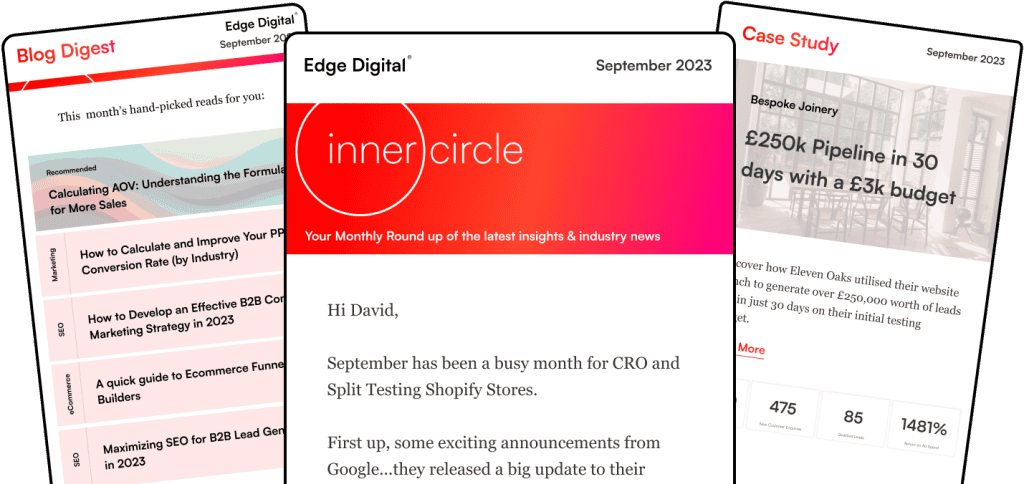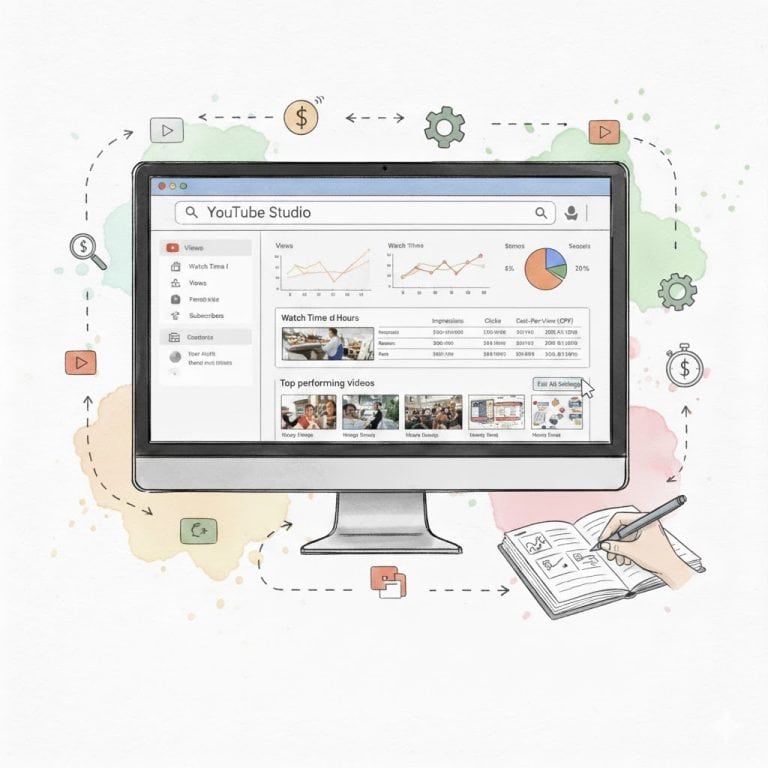In the realm of digital advertising, marketers are often confronted with the decision between leveraging LinkedIn advertising and Google advertising. Both platforms offer unique advantages and are capable tools in a marketer’s arsenal to achieve various business goals. Developing a robust ad campaign on both LinkedIn and Google is crucial for targeting audiences effectively and optimizing ad performance. Our approach to these platforms is shaped by their abilities to target specific audiences, ensure we’re meeting our budgetary constraints and accurately measure our success in generating conversions.
We understand that LinkedIn is a powerhouse for B2B marketing with unparalleled targeting options for professionals, while Google’s vast reach and diverse ad types are second to none for capturing high-intent traffic across the web. Our strategies incorporate the best of both worlds, but choosing the right platform hinges on our specific campaign objectives and the audience we’re looking to engage.
Key Takeaways
LinkedIn advertising excels in professional targeting.
Google advertising provides a wider audience reach.
Strategic platform choice depends on campaign goals.
Understanding LinkedIn Advertising
As we explore LinkedIn Advertising, it’s crucial to recognise its distinct position in the digital marketing landscape, primarily in the context of B2B marketing. We will navigate through the intricacies of LinkedIn’s offer: an in-depth look at how ad types and audience targeting work hand in hand to enhance lead generation and foster professional connections.
LinkedIn Ads Overview
LinkedIn Ads provides a platform tailored to professionals and corporate entities. It’s a powerful tool in our marketing arsenal, especially when our aim is to nurture business relationships and drive industry-relevant traffic to our services or content.
Benefits for B2B Marketing
For B2B marketing, LinkedIn stands out as a goldmine due to its professional user base. With over 722 million members, our ability to connect with decision-makers and influencers across numerous industries is significantly amplified. Leveraging this network means we’re positioned to increase the quality of leads by placing our content squarely in front of professionals actively interested in business solutions.
Ad Types on LinkedIn
LinkedIn’s versatility is evident in its ad types:
Sponsored Content: Ideal for amplifying our reach, these native ads appear directly in the LinkedIn feed, appearing organically to our target audience.
Sponsored InMail: This feature allows us to send personalised messages directly to the LinkedIn inbox of our prospects.
Text Ads: These are simple yet effective, usually found at the top or right-hand side of the LinkedIn page.
Video Ads: These are becoming increasingly popular and can often yield a higher engagement rate as they’re more dynamic and eye-catching.
Image Ads: We can utilise compelling visuals to grab the attention of our audience, perfect for showcasing our brand with immediacy.
Conversation Ads: These personalized ads engage users directly through direct messages on LinkedIn, creating a chat-like experience that leads to high engagement rates.
Message Ads: This type of sponsored messaging allows advertisers to send personalized direct messages to their target audience, featuring call-to-action buttons and emphasizing the importance of targeting for maximum engagement.
Audience Targeting on LinkedIn
Effectiveness in audience targeting on LinkedIn is unparalleled because advertisers can place bids to reach LinkedIn members, utilizing the platform’s extensive segmenting options. We can focus our campaigns by industry, company size, job title, and even by members who have shown an interest in events or specific content. This precision ensures that the lead generation process is more streamlined and that our resources are spent connecting with those most likely to convert.
Understanding Google Advertising
Before diving into the specifics, it’s crucial for us to grasp that Google Advertising encompasses a wide array of ad formats, targeting the right user at the right time through keywords and search intent. Google Ads operate across both the Search and Display Networks, reaching users with various types of ad content.
Google Ads Explained
Google Ads is our gateway to advertising on Google’s platforms. It allows us to create a multitude of ad types, such as search ads, display ads, and more specialised formats like shopping ads and app promotion ads. By placing bids on keywords, our ads may appear in Google’s search results or across their vast Display Network, depending on the campaign settings we choose.
Search vs Display Network
We need to differentiate between the Search Network and the Display Network to effectively use Google Ads. The Search Network targets users with text-based ads that appear on search results pages when specific keywords and search intent are matched. On the other hand, the Display Network extends our reach, displaying ads like image or responsive ads on a variety of websites that host Google ad space.
Video Ads Formats and Types
Google’s ad formats are varied. Let’s list some:
Text Ads: A concise format prominent on the Search Network.
Image Ads: Visual ads designed for the Display Network.
Video Ads: Engaging videos shown on YouTube and across the web.
Shopping Ads: Product listings that appear in search results, often featuring an image, title, price, and store name.
App Promotion Ads: Ads focused on driving app installations.
Call-Only Ads: Ads encouraging users to call our business directly.
Dynamic Ads: Content automatically tailored to users based on their interests and previous interactions.
Each format serves a different purpose and has its own set of best practices.
Keywords and Search Intent
Choosing the right keywords is central to deploying effective Google Ads. We need to understand the search intent behind each keyword to ensure our ads align with what users are seeking. This intent can range from informational to transactional, affecting the choice of ad format, whether text or a more dynamic option like shopping ads. Keywords trigger our ads to appear, so their relevance is paramount.
Targeting Capabilities
In this section, we’re exploring the specific targeting capabilities that distinguish LinkedIn and Google advertising. We’ll dissect their approaches to audience segmentation, demographic and interest targeting, location and language precision, as well as behaviour and retargeting methods.
Audience Segmentation
Audience segmentation on LinkedIn is particularly robust due to its professional context. We can target users based on their job title, company name, and industry, which allows us to reach professionals with precision. LinkedIn enables us to use Matched Audiences, which includes retargeting people who’ve visited our website, as well as targeting contacts from our customer databases.
Creating targeted ad campaigns on LinkedIn and Google is crucial to achieve various objectives such as awareness and conversion. Google Ads, on the other hand, allows us to segment audiences based on search behaviour, which can reflect users’ immediate needs or interests, thus capturing a broad yet relevant audience.
Demographics & Interests
In terms of demographics, LinkedIn offers detailed filters such as company size, seniority level, and years of experience, aligning well with B2B models. The platform allows for targeting interests through groups and professional content users engage with.
Google advertising extends its targeting by interpreting users’ search queries and online behaviour, thereby inferring interests. This wide net is ideal for products and services with a broader appeal and is highly effective for B2C campaigns.
Location & Language Targeting
Both platforms offer location and language targeting. Google Ads has extensive reach, allowing advertisers to target users across the globe and in various languages, which is valuable for reaching a vast audience.
LinkedIn also lets us target by location, even allowing us to specify the radius around a certain area. While its language options might be less extensive than Google’s, LinkedIn’s precision is useful for pinpointing professionals in specific regions.
Behaviour & Retargeting
Behavioural targeting on Google hinges on user search patterns and online activities. Coupled with Google’s powerful analytics, it’s easier for us to implement behavioural targeting and track conversions.
LinkedIn provides a more niche form of behavioural targeting, focusing on professional behaviours and interests, which can be leveraged for higher-value conversions, especially in the B2B space. Retargeting capabilities on both platforms ensure that we can re-engage users who have previously interacted with our ads or website.
Budgeting and Costs
In navigating the avenues of LinkedIn and Google advertising, we recognise the importance of setting a viable budget, comprehending distinct cost models, and assessing the potential Return on Investment (ROI). Our focus remains steadfast on these financial aspects that are crucial to the success of any campaign.
Setting a Budget
When we consider advertising on LinkedIn or Google, the starting budget forms the bedrock of our campaign strategy. A recommended starting budget for LinkedIn Ads is about £3,600 per month, which is projected to yield statistically significant data. This data, in turn, aids us in making informed decisions. On the other hand, Google Ads can accommodate various budget sizes, from small daily spend limits upward, allowing greater flexibility for businesses of all scales.
Understanding Cost Models
Both platforms operate primarily on a Cost-Per-Click (CPC) model, yet each embodies nuances reflective of their bidding systems. LinkedIn generally exhibits a higher CPC due to its B2B emphasis and the valuable professional demographic it hosts. Google Ads might offer a lower CPC, yet its costs are contingent on a myriad of factors which include keyword competition and quality score.
Comparing ROI
Our objective in advertising is to maximise ROI, making it essential to track and analyse performance data carefully. Google Analytics offers comprehensive tools to scrutinise the effectiveness of Google Ads campaigns. It facilitates the evaluation of key metrics, illuminating the path to optimise our ad spend. Although LinkedIn provides its own analytics, the integration with Google Analytics is not as seamless, demanding a more manual approach to measure the efficacy of our investments.
Measuring Success
When we consider the impact of our advertising efforts on LinkedIn and Google, it’s essential to focus on how analytics and reporting, conversion tracking, and engagement metrics can inform us of our campaign’s success. We’ll dissect these elements to understand their role in measuring outcomes effectively.
Analytics and Reporting
We can gain comprehensive insights from LinkedIn’s analytics which allow us to understand who has been viewing and interacting with our ads. LinkedIn provides detailed demographic information about our audience, such as job title and industry, which can be pivotal for B2B campaigns. In contrast, Google Analytics offers a broader range of data, including detailed information about website visitors’ behaviour. Both platforms give us the ability to track impressions and clicks, which are fundamental for assessing the reach and initial interest in our ads.
Conversion Tracking
For us to accurately measure the ROI of our campaigns, conversion tracking is indispensable. On LinkedIn, we can track conversions through LinkedIn Insight Tag, which records when a user takes a desired action on our website after clicking on an ad. Google Ads utilises conversion tracking by placing a piece of code on our website to report when clicks on ads lead to valuable customer activity. It’s crucial that we set up conversion tracking appropriately to ensure that we’re capturing all conversions, whether they are form submissions, sign-ups, or purchases.
Engagement and Interaction Metrics
Engagement and interactions on our ads indicate the level of audience interest and help us optimise our campaigns for better performance. LinkedIn measures engagement through metrics such as likes, shares, comments, and InMail responses. Google focuses on metrics like click-through rate (CTR), which helps us understand the effectiveness of our keywords and ad copy. Analysing these metrics helps us refine our campaign strategies and creative elements to enhance user interaction and engagement with our ads. We strive to improve these metrics as they are closely tied to our campaign success.
In targeting the efficacy of our advertising campaigns, these analytic strategies are vital for achieving a clear and measurable outcome. We continually assess and iterate on these metrics to optimise our approach and maximise the success of our advertising investments.
Strategic Considerations
Before delving into the tactical execution of an advertising campaign, we must consider several strategic elements that will govern our approach. These include clarifying our objectives, selecting the most suitable platform, and crafting a compelling message that resonates with our target audience.
Defining Campaign Goals
In developing our marketing strategy, we first need to set clear goals. Whether our aim is to enhance brand awareness, drive lead generation, or improve conversion rates, the goals we set will direct our entire advertising strategy. It’s critical that our goals are specific, measurable, achievable, relevant, and time-bound (SMART).
Choosing the Right Platform
The choice between Google Advertising and LinkedIn Advertising should align with our audience and user intent. Google Ads excel in capturing active search intent, offering visibility to a broad audience actively seeking solutions. Conversely, LinkedIn Advertising provides a more niche platform, ideal for B2B marketing and connecting with professionals based on job titles and sectors.
Crafting the Message
Once our platform is selected, we must tailor our message. On Google, ads that target specific keywords can drive conversion by aligning with user searches. For LinkedIn, messages that focus on professional development and industry-specific value propositions can foster better lead generation among a network of professionals.
By prioritising these strategic considerations, we lay the foundation for a robust digital marketing campaign tailored to meet our advertising goals.
Platform Pros and Cons
In our discussion of LinkedIn Ads versus Google Ads, it’s essential to address the unique benefits and drawbacks each platform presents. Through this lens, we can better understand how to leverage their features for targeted audience reach and overall campaign success.
LinkedIn for Professional Networking
LinkedIn presents a robust environment for B2B marketing, allowing us to engage with a professional audience. The platform’s strength lies in its ability to target industry professionals based on their job titles, sectors, and seniority levels.
Pros:
Excellent for reaching decision-makers and professionals.
Offers precise targeting options for a professional audience.
Cons:
Typically higher cost per click (CPC) compared to other platforms.
Smaller audience reach due to its professional nature.
LinkedIn Ads offer features that cater particularly well to B2B models, but may not be the first choice for campaigns aimed at a wider audience.
Google for Broad Reach
Google boasts a massive audience reach through its search and display networks, making it ideal for broad targeting and PPC campaigns that aim to attract a diverse audience.
Pros:
Immense reach potential due to Google’s prevalence.
Versatile targeting options, including keywords and demographics.
Cons:
The broad reach can sometimes lead to less qualified leads.
Highly competitive, which can drive up advertising costs.
Through Google Ads, we can capitalise on the platform’s versatility but must navigate the competitive nature that comes with its expansive reach.
Comparative Analysis
When comparing LinkedIn Ads with Google Ads, it’s clear both platforms have unique merits. LinkedIn excels within professional networking, offering tailored solutions for target audience engagement in the corporate world. On the flip side, Google’s broad reach is unmatched for audience targeting across numerous segments, with a focus less on job specifics and more on search intent or content consumption patterns.
Each service’s PPC model rewards well-optimised campaigns — it’s about choosing the tool that aligns with our goals. If niche, professional targeting is our priority, LinkedIn’s features will serve us well. However, for an extensive audience reach and flexibility in campaign types, Google’s far-flung network presents the upper hand.
Future Trends and Updates
As experts in the realm of digital advertising, we continually track the latest advancements to keep our strategies ahead of the curve. Join us as we explore what’s new and what’s next in the world of LinkedIn and Google advertising.
Recent Platform Innovations
LinkedIn has made strides in enhancing its advertising offerings, particularly with the introduction of new features and updates. Sponsored content now has greater capabilities—dynamic ads have become more responsive, appealing to the growing need for personalisation. Furthermore, innovations in LinkedIn’s carousel ads enhance storytelling by allowing multiple images or videos in a single ad, thus providing a richer narrative.
Google Ads is not far behind in the innovation realm. It’s the incorporation of Artificial Intelligence that stands as their most praiseworthy improvement. Google continues to integrate AI into its platform to create more dynamic and tailored ad experiences.
Emerging Digital Advertising Practices
In the ever-evolving landscape of digital advertising, staying current with emerging trends is crucial. The emphasis has been on creating not just responsive but also predictive advertising that resonates with user behaviour and preferences. We’re seeing a focus on direct sponsored content that speaks individually to users and is driven by both data and creative insights.
Moreover, greater emphasis is placed on the seamless integration of ads within a user’s browsing and search experience. Google advertising is heading towards more intuitive and less intrusive ad formats tailored by AI-driven insights, making ads feel more like a natural component of user interaction.
Adopting these practices enables us to utilise the full spectrum of digital advertising’s potential, placing our brands at the forefront of innovation and visibility.
Frequently Asked Questions
In this section, we address common queries regarding the specifics of LinkedIn and Google advertising platforms, delving into targeting capabilities, cost implications, advantages, disadvantages, audience reach, and typical challenges marketers encounter.
What are the key differences in targeting capabilities between LinkedIn Ads and Google Ads?
LinkedIn offers a robust targeting approach, primarily geared towards professionals and businesses, allowing for detailed segmentation based on job title, industry, and professional interests. In contrast, Google Ads extends its targeting to a broader audience, using search intent, keywords, and browsing behaviour to reach potential customers.
How do the costs of advertising on LinkedIn compare with those on Google?
Typically, LinkedIn Ads have a higher cost-per-click (CPC) compared to Google Ads, with LinkedIn commanding premium pricing for its specialised business-focused audience. Google Ads is usually more cost-effective, with broader reach across the internet.
Can you outline the main advantages and disadvantages of using LinkedIn Ads versus Google Ads?
Advantages of using LinkedIn Ads include their precise B2B targeting and access to a professional network. The downsides might be higher costs and a more niche platform. Google Ads, conversely, provides extensive reach and varied ad formats at a lower cost, but might lack the precision for specialised B2B markets.
What audiences are more effectively reached through LinkedIn Advertising compared to Google Advertising?
LinkedIn’s primary focus is B2B marketing, making it more effective at reaching professionals, decision-makers, and specific industry niches. Google’s wide net captures diverse audiences, which is ideal for B2C and broader B2B campaigns.
How does the effectiveness of LinkedIn advertising measure up against the industry benchmark?
Determining the effectiveness of LinkedIn advertising is contingent on the alignment with campaign objectives and the ability to reach desired B2B audiences. LinkedIn often surpasses benchmarks for engagement within professional circles but can vary based on campaign execution and relevance.
What are some common challenges marketers face when using LinkedIn for advertising?
Marketers may encounter challenges such as aligning content to the professional tone of LinkedIn, adjusting to higher advertising costs, and finding the right balance of targeting to avoid overly narrow or broad outreach.



